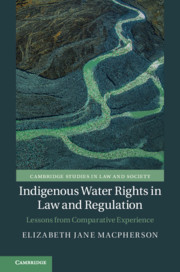Book contents
- Indigenous Water Rights in Law and Regulation
- Cambridge Studies in Law and Society
- Indigenous Water Rights in Law and Regulation
- Copyright page
- Dedication
- Contents
- Acknowledgements
- Chapter One Introduction
- Part I Conceptualising Indigenous Water Rights
- Part II Comparative Country Studies
- Chapter Four The Limited Recognition of Indigenous Water Rights in Australia
- Chapter Five Water Rights for Māori in Aotearoa New Zealand
- Chapter Six Rivers as Subjects and Indigenous Water Rights in Colombia
- Chapter Seven Recognising and Allocating Indigenous Water Rights in Chile
- Part III Lessons Learnt
- Glossary
- Bibliography
- Index
- Cambridge Studies in Law and Society
Chapter Six - Rivers as Subjects and Indigenous Water Rights in Colombia
from Part II - Comparative Country Studies
Published online by Cambridge University Press: 20 July 2019
- Indigenous Water Rights in Law and Regulation
- Cambridge Studies in Law and Society
- Indigenous Water Rights in Law and Regulation
- Copyright page
- Dedication
- Contents
- Acknowledgements
- Chapter One Introduction
- Part I Conceptualising Indigenous Water Rights
- Part II Comparative Country Studies
- Chapter Four The Limited Recognition of Indigenous Water Rights in Australia
- Chapter Five Water Rights for Māori in Aotearoa New Zealand
- Chapter Six Rivers as Subjects and Indigenous Water Rights in Colombia
- Chapter Seven Recognising and Allocating Indigenous Water Rights in Chile
- Part III Lessons Learnt
- Glossary
- Bibliography
- Index
- Cambridge Studies in Law and Society
Summary
In Chapter 6 I examine indigenous water rights in Colombia, specifically, the declaration by Colombia’s highest court that the Atrato River is a ‘legal subject’ in response to indigenous concerns about water management. This watershed case of November 2016 was an action for protection of constitutional rights brought in the Colombian Constitutional Court on behalf of a number of indigenous and afrodescendent communities, in response to serious environmental and humanitarian damage caused by illegal mining in the region of Chocó. I show in this chapter how the legal person model for the Atrato is adopted in recognition of the ‘biocultural rights’ of indigenous communities, but the approach is clearly not a complete answer to indigenous water injustice. Indigenous peoples also need substantive water allocations, in order to have a voice in decision making about river management and use. Yet, because the river is a subject it has representatives from the community, or guardians, and they have a voice on behalf of the river, where previously they had none. The Colombian case is highly significant, in that it underscores the strength of legal person models in creating new jurisdictions for indigenous peoples in which to participate in river sharing, governance and use.
Keywords
- Type
- Chapter
- Information
- Indigenous Water Rights in Law and RegulationLessons from Comparative Experience, pp. 131 - 160Publisher: Cambridge University PressPrint publication year: 2019
- 2
- Cited by

